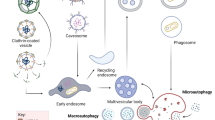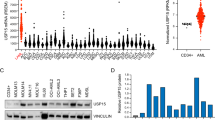Abstract
The modification of proteins with ubiquitin is involved in the regulation of various important biological pathways. A crucial step in this process is the modification of specific substrate proteins with ubiquitin by E3 ligases. The ubiquitylation of proteins can result in altered protein function or degradation by the 26S proteasome. Various proteins playing an important role during hematopoiesis are regulated via ubiquitin modification. Recently, alterations in ubiquitylation and proteasomal degradation have been implicated in hematological cancers. Based on these findings, novel therapies that specifically target ubiquitylation or the proteasome are currently being developed. In this review, we will highlight the role of ubiquitylation in normal and malignant hematopoiesis and discuss novel therapeutical approaches that are now tested in various hematological malignancies.
This is a preview of subscription content, access via your institution
Access options
Subscribe to this journal
Receive 12 print issues and online access
$259.00 per year
only $21.58 per issue
Buy this article
- Purchase on Springer Link
- Instant access to full article PDF
Prices may be subject to local taxes which are calculated during checkout





Similar content being viewed by others
References
Fang S, Weissman AM . A field guide to ubiquitylation. Cell Mol Life Sci 2004; 61: 1546–1561.
Pickart CM . Back to the future with ubiquitin. Cell 2004; 116: 181–190.
Ardley HC, Robinson PA . E3 ubiquitin ligases. Essays Biochem 2005; 41: 15–30.
Wilkinson KD . Ubiquitination and deubiquitination: targeting of proteins for degradation by the proteasome. Semin Cell Dev Biol 2000; 11: 141–148.
d'Azzo A, Bongiovanni A, Nastasi T . E3 ubiquitin ligases as regulators of membrane protein trafficking and degradation. Traffic 2005; 6: 429–441.
Haglund K, Dikic I . Ubiquitylation and cell signaling. EMBO J 2005; 24: 3353–3359.
Sun L, Chen ZJ . The novel functions of ubiquitination in signaling. Curr Opin Cell Biol 2004; 16: 119–126.
Hofmann RM, Pickart CM . Noncanonical MMS2-encoded ubiquitin-conjugating enzyme functions in assembly of novel polyubiquitin chains for DNA repair. Cell 1999; 96: 645–653.
Huang TT, D'Andrea AD . Regulation of DNA repair by ubiquitylation. Nat Rev Mol Cell Biol 2006; 7: 323–334.
Adhikary S, Marinoni F, Hock A, Hulleman E, Popov N, Beier R et al. The ubiquitin ligase HectH9 regulates transcriptional activation by Myc and is essential for tumor cell proliferation. Cell 2005; 123: 409–421.
Chen ZJ . Ubiquitin signalling in the NF-kappaB pathway. Nat Cell Biol 2005; 7: 758–765.
Jura N, Scotto-Lavino E, Sobczyk A, Bar-Sagi D . Differential modification of Ras proteins by ubiquitination. Mol Cell 2006; 21: 679–687.
Pickart CM, Fushman D . Polyubiquitin chains: polymeric protein signals. Curr Opin Chem Biol 2004; 8: 610–616.
Rubin DM, Finley D . Proteolysis. The proteasome: a protein-degrading organelle? Curr Biol 1995; 5: 854–858.
Adams J . The proteasome: a suitable antineoplastic target. Nat Rev Cancer 2004; 4: 349–360.
Hendil KB, Hartmann-Petersen R . Proteasomes: a complex story. Curr Protein Peptide Sci 2004; 5: 135–151.
Rivett AJ, Hearn AR . Proteasome function in antigen presentation: immunoproteasome complexes, peptide production, and interactions with viral proteins. Curr Protein Peptide Sci 2004; 5: 153–161.
Kloetzel PM, Ossendorp F . Proteasome and peptidase function in MHC-class-I-mediated antigen presentation. Curr Opin Immunol 2004; 16: 76–81.
Nijman SM, Luna-Vargas MP, Velds A, Brummelkamp TR, Dirac AM, Sixma TK et al. A genomic and functional inventory of deubiquitinating enzymes. Cell 2005; 123: 773–786.
Migone TS, Humbert M, Rascle A, Sanden D, D'Andrea A, Johnston JA . The deubiquitinating enzyme DUB-2 prolongs cytokine-induced signal transducers and activators of transcription activation and suppresses apoptosis following cytokine withdrawal. Blood 2001; 98: 1935–1941.
Burrows JF, McGrattan MJ, Rascle A, Humbert M, Baek KH, Johnston JA . DUB-3, a cytokine-inducible deubiquitinating enzyme that blocks proliferation. J Biol Chem 2004; 279: 13993–14000.
Paulsson K, Bekassy AN, Olofsson T, Mitelman F, Johansson B, Panagopoulos I . A novel and cytogenetically cryptic t(7;21)(p22;q22) in acute myeloid leukemia results in fusion of RUNX1 with the ubiquitin-specific protease gene USP42. Leukemia 2006; 20: 224–229.
Brummelkamp TR, Nijman SM, Dirac AM, Bernards R . Loss of the cylindromatosis tumour suppressor inhibits apoptosis by activating NF-kappaB. Nature 2003; 424: 797–801.
Kovalenko A, Chable-Bessia C, Cantarella G, Israel A, Wallach D, Courtois G . The tumour suppressor CYLD negatively regulates NF-kappaB signalling by deubiquitination. Nature 2003; 424: 801–805.
Boone DL, Turer EE, Lee EG, Ahmad RC, Wheeler MT, Tsui C et al. The ubiquitin-modifying enzyme A20 is required for termination of Toll-like receptor responses. Nat Immunol 2004; 5: 1052–1060.
Rape M, Jentsch S . Productive RUPture: activation of transcription factors by proteasomal processing. Biochim Biophys Acta 2004; 1695: 209–213.
Lin L, Ghosh S . A glycine-rich region in NF-kappaB p105 functions as a processing signal for the generation of the p50 subunit. Mol Cell Biol 1996; 16: 2248–2254.
Tenen DG . Disruption of differentiation in human cancer: AML shows the way. Nat Rev Cancer 2003; 3: 89–101.
Diehl JA, Zindy F, Sherr CJ . Inhibition of cyclin D1 phosphorylation on threonine-286 prevents its rapid degradation via the ubiquitin–proteasome pathway. Genes Dev 1997; 11: 957–972.
Dimmeler S, Breitschopf K, Haendeler J, Zeiher AM . Dephosphorylation targets Bcl-2 for ubiquitin-dependent degradation: a link between the apoptosome and the proteasome pathway. J Exp Med 1999; 189: 1815–1822.
Huang G, Shigesada K, Ito K, Wee HJ, Yokomizo T, Ito Y . Dimerization with PEBP2beta protects RUNX1/AML1 from ubiquitin–proteasome-mediated degradation. EMBO J 2001; 20: 723–733.
Minegishi N, Suzuki N, Kawatani Y, Shimizu R, Yamamoto M . Rapid turnover of GATA-2 via ubiquitin–proteasome protein degradation pathway. Genes Cells 2005; 10: 693–704.
Shim M, Smart RC . Lithium stabilizes the CCAAT/enhancer-binding protein alpha (C/EBPalpha) through a glycogen synthase kinase 3 (GSK3)-independent pathway involving direct inhibition of proteasomal activity. J Biol Chem 2003; 278: 19674–19681.
Marteijn JA, van der Meer LT, van Emst L, de Witte T, Jansen JH, van der Reijden BA . Diminished proteasomal degradation results in accumulation of Gfi1 protein in monocytes. Blood (in press).
Marteijn JA, van Emst L, Erpelinck-Verschueren CA, Nikoloski G, Menke A, de Witte T et al. The E3 ubiquitin–protein ligase Triad1 inhibits clonogenic growth of primary myeloid progenitor cells. Blood 2005; 106: 4114–4123.
Chuang TH, Ulevitch RJ . Triad3A, an E3 ubiquitin–protein ligase regulating Toll-like receptors. Nat Immunol 2004; 5: 495–502.
Li B, Yang FC, Clapp DW, Chun KT . Enforced expression of CUL-4A interferes with granulocytic differentiation and exit from the cell cycle. Blood 2003; 101: 1769–1776.
Zhang Y, Morrone G, Zhang J, Chen X, Lu X, Ma L et al. CUL-4A stimulates ubiquitylation and degradation of the HOXA9 homeodomain protein. EMBO J 2003; 22: 6057–6067.
Elliott J, Johnston JA . SOCS: role in inflammation, allergy and homeostasis. Trends Immunol 2004; 25: 434–440.
Ungureanu D, Saharinen P, Junttila I, Hilton DJ, Silvennoinen O . Regulation of Jak2 through the ubiquitin–proteasome pathway involves phosphorylation of Jak2 on Y1007 and interaction with SOCS-1. Mol Cell Biol 2002; 22: 3316–3326.
Peschard P, Park M . Escape from Cbl-mediated downregulation: a recurrent theme for oncogenic deregulation of receptor tyrosine kinases. Cancer Cell 2003; 3: 519–523.
Bache KG, Slagsvold T, Stenmark H . Defective downregulation of receptor tyrosine kinases in cancer. EMBO J 2004; 23: 2707–2712.
Pagano M, Benmaamar R . When protein destruction runs amok, malignancy is on the loose. Cancer Cell 2003; 4: 251–256.
Pastore Y, Jedlickova K, Guan Y, Liu E, Fahner J, Hasle H et al. Mutations of von Hippel–Lindau tumor-suppressor gene and congenital polycythemia. Am J Hum Genet 2003; 73: 412–419.
D'Andrea AD, Grompe M . The Fanconi anaemia/BRCA pathway. Nat Rev Cancer 2003; 3: 23–34.
Nijman SM, Huang TT, Dirac AM, Brummelkamp TR, Kerkhoven RM, D'Andrea AD et al. The deubiquitinating enzyme USP1 regulates the Fanconi anemia pathway. Mol Cell 2005; 17: 331–339.
Konikova E, Kusenda J . Altered expression of p53 and MDM2 proteins in hematological malignancies. Neoplasma 2003; 50: 31–40.
Zhou M, Yeager AM, Smith SD, Findley HW . Overexpression of the MDM2 gene by childhood acute lymphoblastic leukemia cells expressing the wild-type p53 gene. Blood 1995; 85: 1608–1614.
Linggi B, Muller-Tidow C, van de Locht L, Hu M, Nip J, Serve H et al. The t(8;21) fusion protein, AML1 ETO, specifically represses the transcription of the p14(ARF) tumor suppressor in acute myeloid leukemia. Nat Med 2002; 8: 743–750.
Pomerantz J, Schreiber-Agus N, Liegeois NJ, Silverman A, Alland L, Chin L et al. The Ink4a tumor suppressor gene product, p19Arf, interacts with MDM2 and neutralizes MDM2's inhibition of p53. Cell 1998; 92: 713–723.
Bahram F, von der Lehr N, Cetinkaya C, Larsson LG . c-Myc hot spot mutations in lymphomas result in inefficient ubiquitination and decreased proteasome-mediated turnover. Blood 2000; 95: 2104–2110.
Hideshima T, Richardson P, Chauhan D, Palombella VJ, Elliott PJ, Adams J et al. The proteasome inhibitor PS-341 inhibits growth, induces apoptosis, and overcomes drug resistance in human multiple myeloma cells. Cancer Res 2001; 61: 3071–3076.
Richardson PG, Sonneveld P, Schuster MW, Irwin D, Stadtmauer EA, Facon T et al. Bortezomib or high-dose dexamethasone for relapsed multiple myeloma. N Engl J Med 2005; 352: 2487–2498.
Chauhan D, Catley L, Li G, Podar K, Hideshima T, Velankar M et al. A novel orally active proteasome inhibitor induces apoptosis in multiple myeloma cells with mechanisms distinct from Bortezomib. Cancer Cell 2005; 8: 407–419.
Amiri KI, Horton LW, LaFleur BJ, Sosman JA, Richmond A . Augmenting chemosensitivity of malignant melanoma tumors via proteasome inhibition: implication for bortezomib (VELCADE, PS-341) as a therapeutic agent for malignant melanoma. Cancer Res 2004; 64: 4912–4918.
Meusser B, Hirsch C, Jarosch E, Sommer T . ERAD: the long road to destruction. Nat Cell Biol 2005; 7: 766–772.
Obeng EA, Carlson LM, Gutman DM, Harrington Jr WJ, Lee KP, Boise LH . Proteasome inhibitors induce a terminal unfolded protein response in multiple myeloma cells. Blood 2006; 107: 4907–4916.
Cenci S, Mezghrani A, Cascio P, Bianchi G, Cerruti F, Fra A et al. Progressively impaired proteasomal capacity during terminal plasma cell differentiation. EMBO J 2006; 25: 1104–1113.
Voorhees PM, Orlowski RZ . The proteasome and proteasome inhibitors in cancer therapy. Annu Rev Pharmacol Toxicol 2006; 46: 189–213.
Richardson PG, Mitsiades C . Bortezomib: proteasome inhibition as an effective anticancer therapy. Future Oncol 2005; 1: 161–171.
Verma R, Peters NR, D'Onofrio M, Tochtrop GP, Sakamoto KM, Varadan R et al. Ubistatins inhibit proteasome-dependent degradation by binding the ubiquitin chain. Science 2004; 306: 117–120.
Vassilev LT, Vu BT, Graves B, Carvajal D, Podlaski F, Filipovic Z et al. In vivo activation of the p53 pathway by small-molecule antagonists of MDM2. Science 2004; 303: 844–848.
Kojima K, Konopleva M, Samudio IJ, Shikami M, Cabreira-Hansen M, McQueen T et al. MDM2 antagonists induce p53-dependent apoptosis in AML: implications for leukemia therapy. Blood 2005; 106: 3150–3159.
Coll-Mulet L, Iglesias-Serret D, Santidrian AF, Cosialls AM, de Frias M, Castano E et al. MDM2 antagonists activate p53 and synergize with genotoxic drugs in B-cell chronic lymphocytic leukemia cells. Blood 2006; 107: 4109–4114.
Author information
Authors and Affiliations
Corresponding author
Rights and permissions
About this article
Cite this article
Marteijn, J., Jansen, J. & van der Reijden, B. Ubiquitylation in normal and malignant hematopoiesis: novel therapeutic targets. Leukemia 20, 1511–1518 (2006). https://doi.org/10.1038/sj.leu.2404319
Received:
Revised:
Accepted:
Published:
Issue Date:
DOI: https://doi.org/10.1038/sj.leu.2404319



